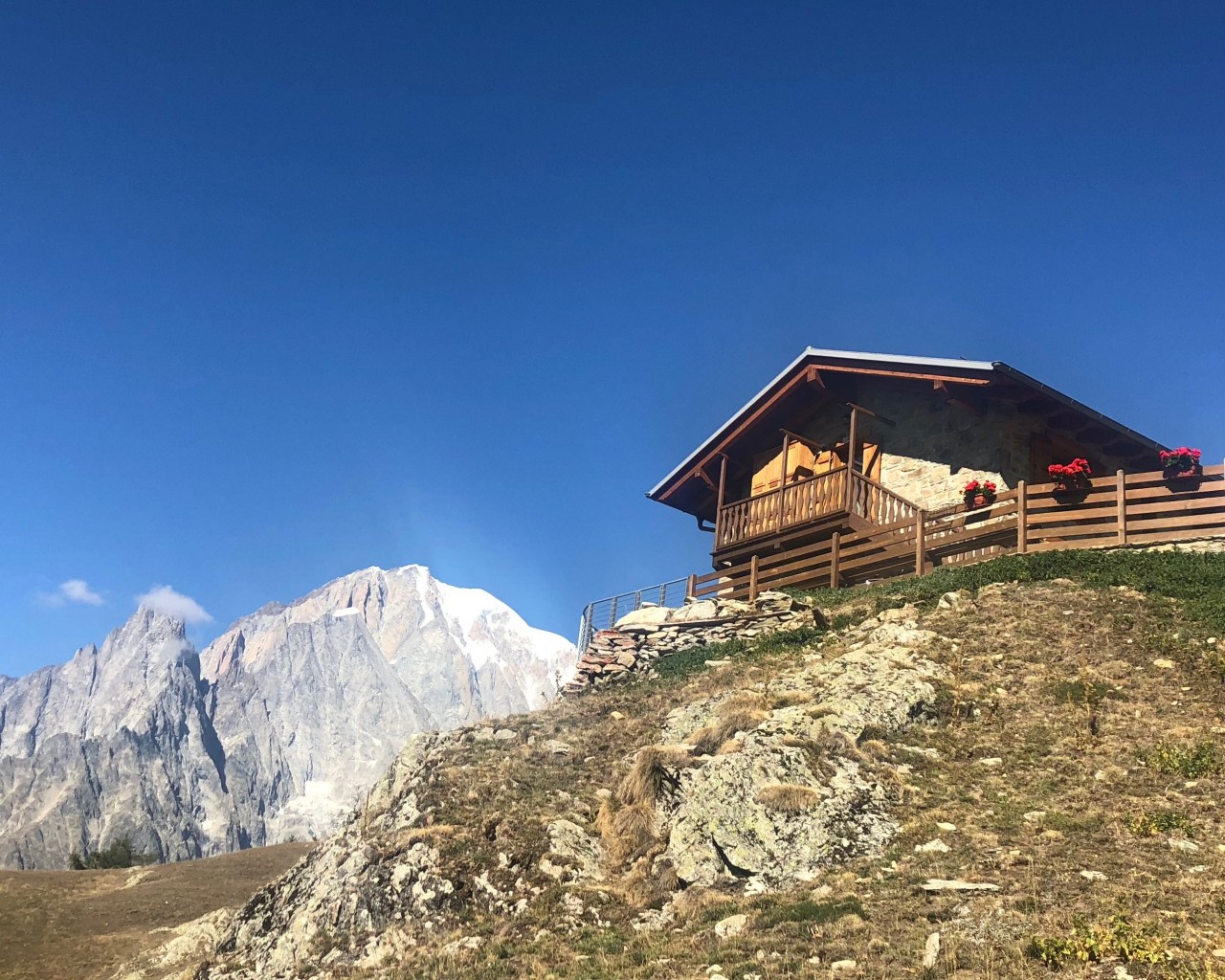 The Rifugio Bertone, in Italy, like many mountain huts sits in a beautiful location.
The Rifugio Bertone, in Italy, like many mountain huts sits in a beautiful location.
Staying in a mountain hut in a remote and beautiful location is to be savoured. It is a wonderful experience and something which everyone who loves the outdoors should try at least once in their lives. There are many reasons for spending a night in a mountain hut, not least because it allows you to enjoy the high mountains in a wild and natural setting where you can escape the cares of everyday life. Nothing could be more relevant today as we remain in 'lockdown' in our homes. For now we can but dream of those 'mountain nights'.
Over the years we have experienced various reactions from our guests when we have pointed out there is a 'hut' night on a particular trip. From excited anticipation of being high in the mountains, to downright horror of sharing a dormitory bedroom with 'strangers'.
We would say 'give it a go' as you might be surprised, after all it is one night of your life and you will most likely survive the experience! But we do recognise that it can be a daunting thought and there are plenty of horror stories about uncomfortable, sleepless nights in huts. However, with some research and a better understanding, some of the common misconceptions about staying in a hut can be overcome.
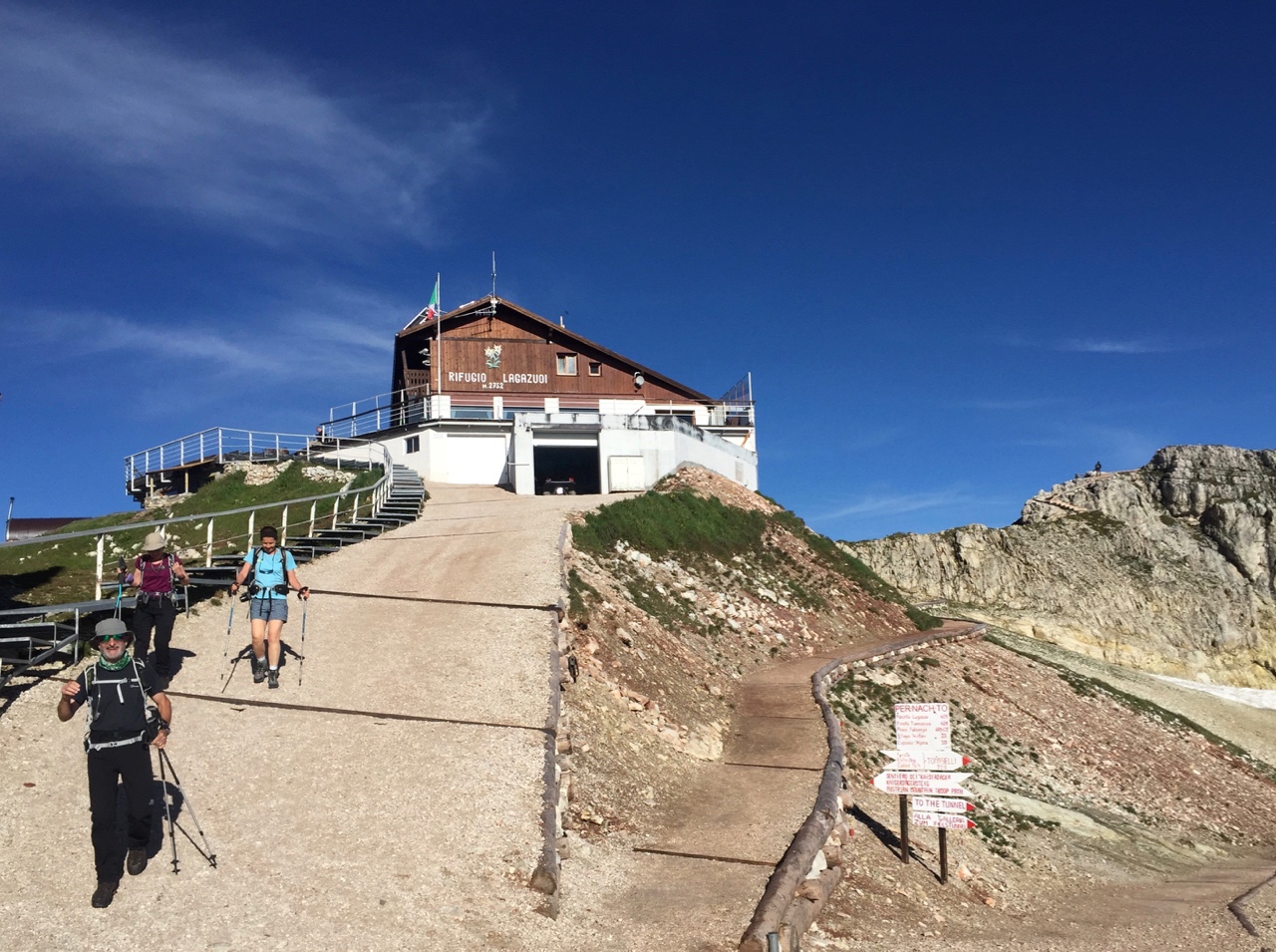
The Rifugio Lagazuoi on the Alta Via 1 in the Dolomites is perched on a cliff top - stunning!
There are many names for accommodation situated in remote mountain locations, but essentially it is the same thing. It is accommodation providing a bed, and food in a place where otherwise you would have to carry a tent and camp, or spend a long time descending to the valley to find somewhere to stay.
We are very lucky that we have this amazing system of mountain accommodation. Mountain huts, rifugi, refuges, and cabanes are all typically the same thing and have different names depending on the country you are in. In Switzerland, and Austria for example, the name 'hut' or 'cabane' is widely used, in France 'refuge', and in Italy 'rifugio.
A mountain hut is a purpose-built structure usually in a strategic location in the mountains that allows people to hike or ski in remote areas and have somewhere safe and warm to stay that serves food. The huts drastically reduce the amount of kit you need to carry with you and are often built in some spectacular locations, for example, the Rifugio Lagazuoi in the Dolomites built at 2752m and the Rifugio Teodulo at 3316m next to the mighty Matterhorn.
The location is carefully chosen in terms of terrain that avoids any risk from avalanches, or rock fall. It will be near to a water source if at all possible, and there will be a flat area of ground or a wooden platform nearby where the helicopter bringing supplies can safely land. The huts will also be located where it allows a day long journey to be made from one hut to the other, in other words, it is rare to find any two huts side-by-side as the principle is to provide accommodation where there would otherwise be none available.
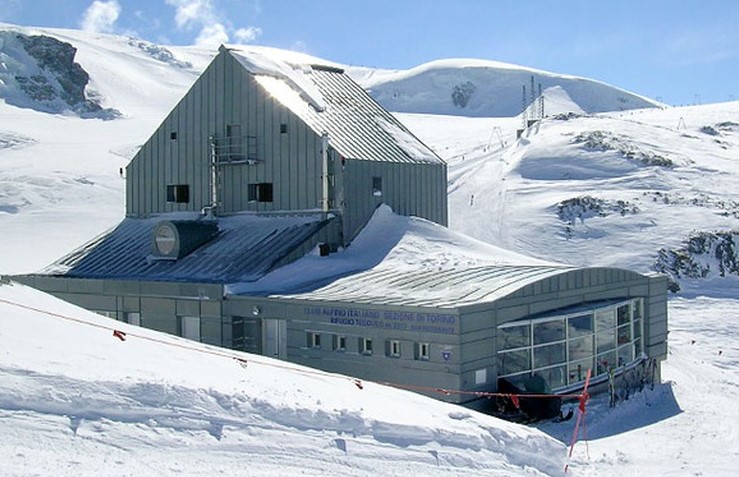
Rifugio Theodulo has the most stunning views to the iconic Matterhorn. A wonderful haven in both summer and winter
Mountain huts and Rifugio are mostly open in the summer from June until late September to provide facilities for hikers and climbers. They are often open in some of the winter months from March to May for cross-country/Nordic ski touring and alpine ski touring as well as winter climbing snowshoeing and hiking.
Some huts are large and more hotel-like, common in Italy and Austria; others can be small and have been converted from an old farm situated high in an alpine pasture. When a hut is open and staffed it is managed by a guardian and their team of staff who take care of guests, cook food and keep the hut clean and tidy.
If you're booking a trip via a tour operator, like Tracks and Trails, then they will make all hut/rifugio bookings on your behalf, bed spaces are often booked months in advance as some routes are busy and huts can be full every night for the whole season.
Here are some things to try to help understand how a mountain hut functions which can make your stay more enjoyable.
Service in a hut can often be found to be perfunctory. You need to appreciate that huts are busy places with people coming and going every day at all hours of the day and night, they are often run on minimal staffing and staff can be working 12 hour days or more repeatedly for 3-4 months.
Please be aware of the pressures they are under and cut the hut staff 'some slack'. Often their manner is more of a cultural difference, rather than meant to be rude. So if you are unused to travel to Europe or it’s your first stay in a hut try to go with an open mind, relaxed attitude and appreciate that they are not 4* hotels with room service.
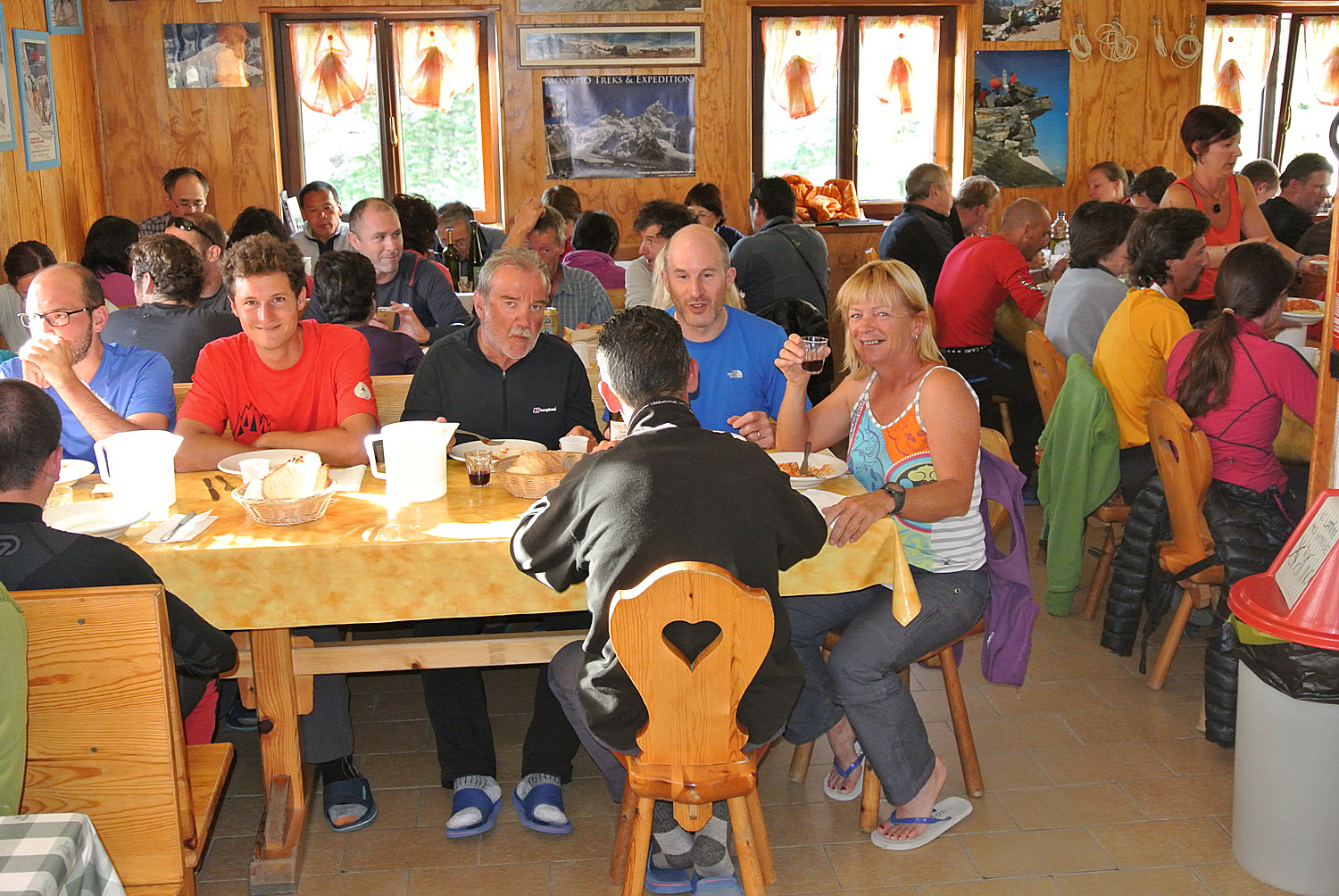
Evening meals are a time to reflect on the day, tell stories and to make new friends. The food is simple, hearty and plentiful
Routine in the hut – huts typically run to a strict timetable for meals and hell-hath-no-fury should you try to change this for your own convenience! Appreciate that they are often cooking meals for 100+ people per day in a small kitchen with a limited selection of food. They have to provide breakfast then often lunch for anyone passing by the hut or those that arrive early and want a late lunch then a 3-course meal in the evening for all those who are staying.
On arrival, your guide will check you into the hut and confirm rooming arrangements and talk you through how the hut works and any specific things you should know about. This way you can avoid incurring the wrath of the staff and have a pleasant stay.
Kit room and your gear organization – on arrival, once the group is checked-in, you need to negotiate the kit room. The first ‘rule’ is under no circumstance do you go straight into the hut in your boot’s, with your rucksack on and head for your bedroom. The kit room is usually located adjacent to the main entrance, in the kit room will be shelves and lots of boxes or baskets for kit to be placed in. Take off your boots and select a pair of hut slippers (usually ‘Croc’ style shoes) to wear inside the hut. We would advise keeping your socks on from a hygiene point of view.
Put your boots on a shelf and take a box/basket into which you need to place all items you don’t need in your room, especially if you are carrying any metal items such as walking poles; no pointy objects inside the hut! If you have wet clothing, then this can be hung in the kit room or taken into the main communal living space and hung by the fire. Your rucksack can then be taken to your room with only the items you need for the night’s stay.
Keeping your kit organized is essential as it will stop you ‘losing it’ or leaving it behind or it being mistaken by someone else.
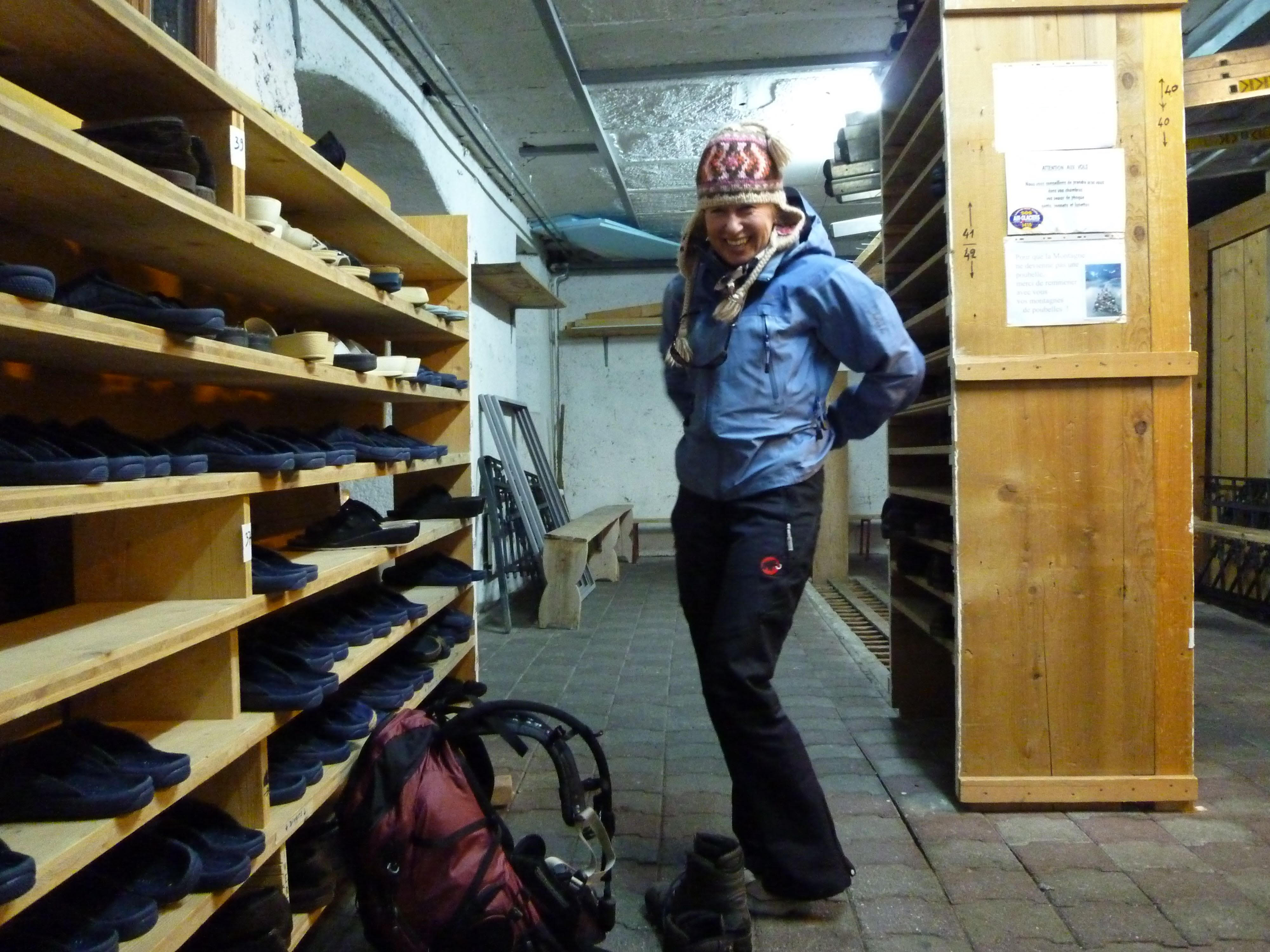
Huts supply slippers/crocs so that you do not have to wear your boots, in fact you are not allowed to wear boots indoors
Sleeping arrangements and washing facilities – some huts, often many of the rifugio’s in Italy can be more like a hotel with private rooms and even ensuite shower and toilet facilities. Usually, this is because they have road or cable car access and servicing them is easy. Others, often high in the mountains in remote, but often popular places have to sleep up to 100 or more people every night so accommodation can generally be in dormitory-style rooms with bunk beds with 10 – 20 people per room.
If private rooms are available then Tracks and Trails will always endeavor to secure them for our trips, however, in popular places, everyone wants them so it may not be possible and accommodation may be in bigger rooms of 4/6/8 to a room. Washing facilities can vary from ensuite bathrooms (shower, sink, toilet) to shared facilities of mixed-sex.
Showers are usually available, but for a small free. For example about 4 Euros for a 3-5 minute shower. Showers are on 'timers' as water is often scarce and it's important not to use more than you absolutely need. 'Short' showers are all part of staying in a mountain hut and while we appreciate it might be a very different experience to what you are used to if you want to visit these remote and beautiful areas then it is something you have to accept and come to terms with.
We are often asked about privacy, for example, getting dressed/undressed in a dormitory bedroom. Over many years of staying in huts I have only rarely felt my privacy 'invaded'. Normally, if you need to undress/dress then others in the dormitory will keep their eyes down, and not direct their gaze in your direction. There is a protocol to how things are done, and respect for privacy is acknowledged and people behave accordingly.
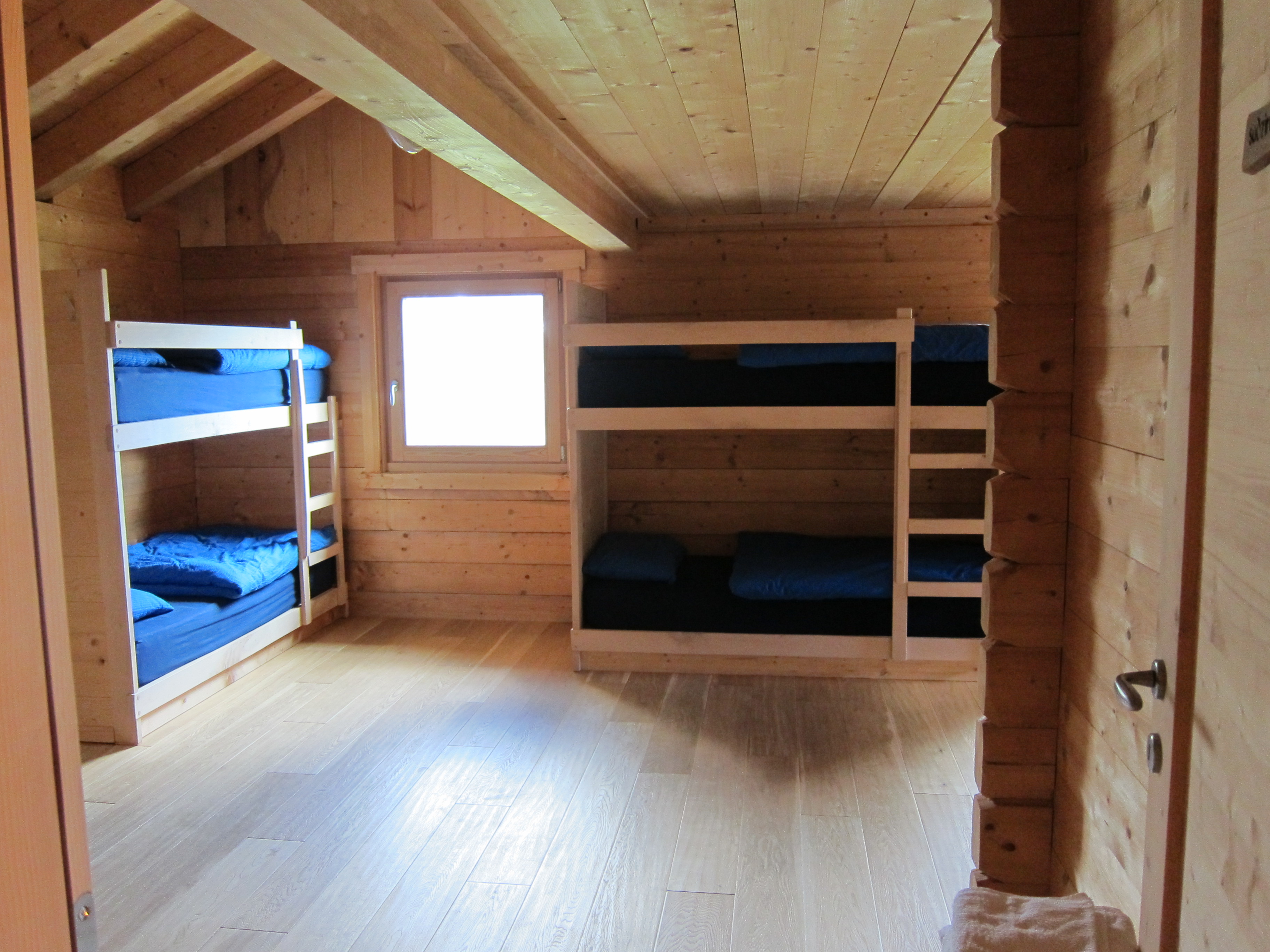
The sleeping arrangements are usually dormitory style, but in some huts private twin/double rooms are available
Meals in mountain huts are usually wholesome and filling; and often you are offered second or third helpings of a particular dish! The food might be basic, but you will not be left hungry. However, you should appreciate that the staff are often turning out food constantly all day for a stream of hungry hikers/skiers and they don’t have a fully stocked supermarket just down the road for every ingredient possible. Often all supplies are brought in by helicopter and have been pre-ordered often weeks in advance, fresh fruit and vegetables are served, but not always in abundance.
If you have dietary requirements then huts will do what they can to provide for vegetarian/vegan/gluten-free diets, but you cannot expect restaurant standard food everywhere and often alternative meals are limited and must be pre-booked with the hut in advance. Dinner is served promptly at around 1800hrs and breakfast can be served anytime from 0600hrs or earlier for 1-2hrs.
It is important to respect these meal times and not to expect the hut to serve meals around your schedule. You can buy additional food and drink in all huts and they will have wine, beer, soft drinks, water, and snack food to staunch any hunger pangs until dinner is ready. Our attitude is that we should be grateful to be fed, and to have avoided the necessity of carrying all our own supplies.
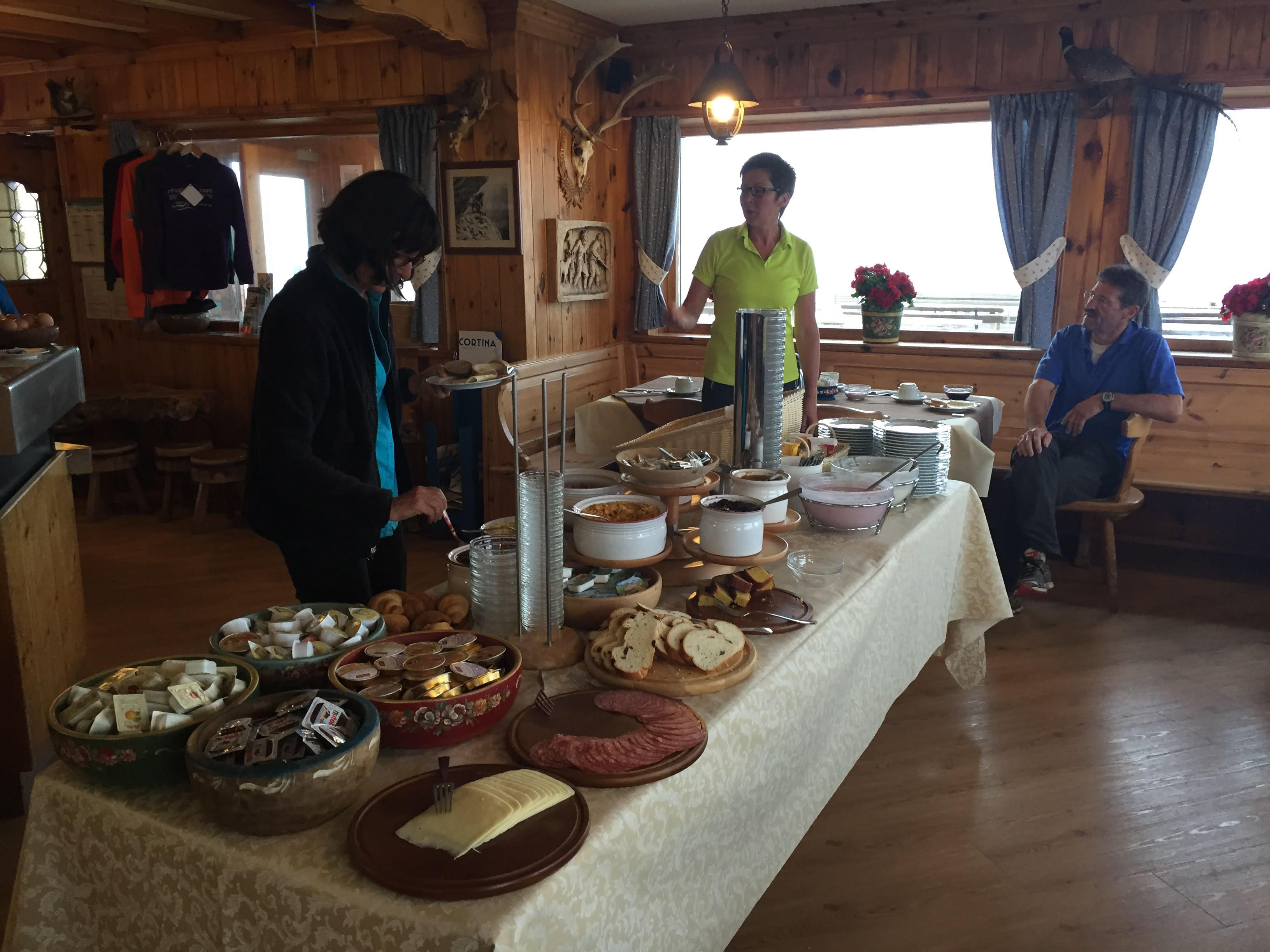
Food is simple, plentiful and filling, usually designed to 'power you up a mountain' the next day. If not quality, then definitely quantity!
Bedtime or lights out is usually by 2200hrs and you are expected to be quiet if you stay up later. If you want to continue to chat with your new found friends, then its best to go outside to prevent annoying your fellow guests and the staff. However, beware of getting locked out of the hut after the staff have gone to bed!
In the morning you need to be up and ready to get your breakfast before leaving the hut. It is very important to eat something, no matter how early the hour, and whether you are hungry or not. Hut breakfasts are usually bread and jam, cereal, and yogurt with plenty of tea and coffee. In short - just be grateful for whatever you are given and be happy to be fed high in the mountains where popping out to the supermarket is not an option.
Most huts are fairly basic wooden or stone structures, some are modern and recently built and others are centuries old. All will have a large communal living/dining area where meals are served, and you can sit and chat with your group and socialise. You will normally be asked to 'clear' this area for a period of time early evening if staff need to set the tables for dinner.
The rest of the hut space is usually bedrooms and washing facilities and the private areas for the hut staff. There is often an outside space with seating depending on the location of the hut where you can enjoy the sunset with an 'apero'. The picture below of the Bonatti Refuge on the Tour du Mont Blanc, in Italy, is perfect for a pre-dinner drink.
Most huts now provide some kind of phone charging station, this might be in the main living room and is shared with all those staying in the hut; don’t expect plugs in all bedrooms. Also, be aware that you should be generous and share the power source. In other words do not 'hog' the only plugs for your own devices as many people, especially the guides, will want to charge phones or satellite phones which may be used for an emergency in the mountains.
Good quality wifi is not always available nor is a phone signal. More remote mountain huts just don’t have the facilities for this; so relax and enjoy not being connected to the world. It is a wonderful excuse to escape. If you desperately need to 'connect' to the outside world, then in an emergency, but only an emergency, the hut will let you use their phone.
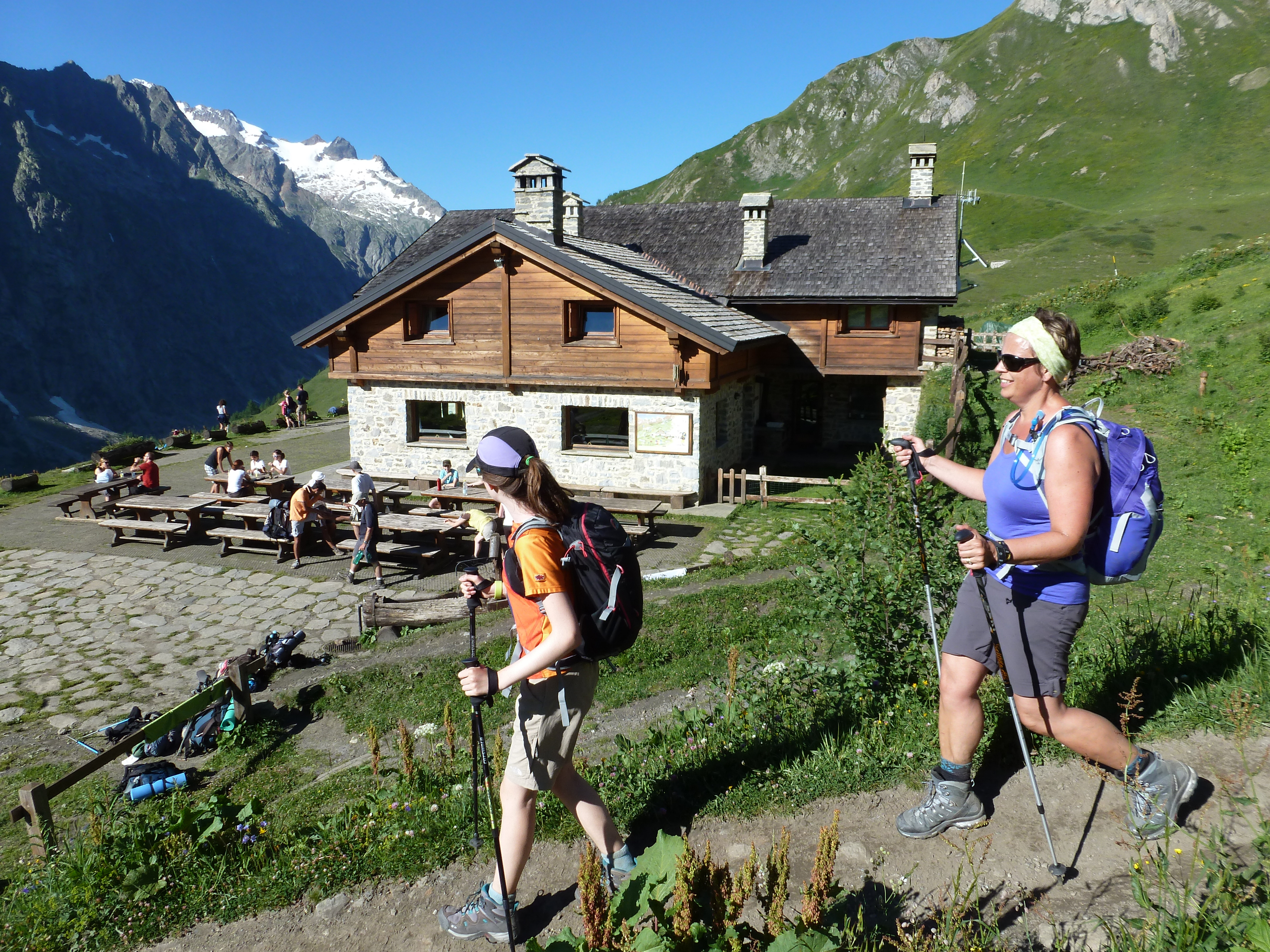
The Rifugio Bonatti, Italy is a welcome sight at the end of a long day of hiking. One of our favourite overnights in the mountain
Things to take with you – If your trip has a night in a mountain hut then there are a few things you need to have in your rucksack for this which will make your stay more comfortable. All huts ask you to use a sleeping bag liner, this is a silk or cotton 'liner' to use in bed for hygiene reasons. A full 'sleeping bag 'is not required.
Bring a set of earplugs with you as this can really improve your night's sleep. You should bring a pack towel for washing, as huts don’t provide these as standard, although sometimes you can often rent one for a small fee.
You will need a head torch and we advise you keep it handy by your pillow ready for night-time trips to the bathroom as turning the lights on in the room with other occupants will not make you the most popular person. Other items include a small wash kit, ideally with miniature soaps/toothpaste etc. You might want a luxury item such as a book/Kindle if you are prepared to carry a little more weight in your rucksack.
Some people also bring their own slippers/Crocs as they would prefer not to wear shoes that have already been worn by hundreds of other people. Also, think about sharing - if you are a 'couple' or good friends then consider bringing only one set of sunscreen, toothpaste, soap, etc.
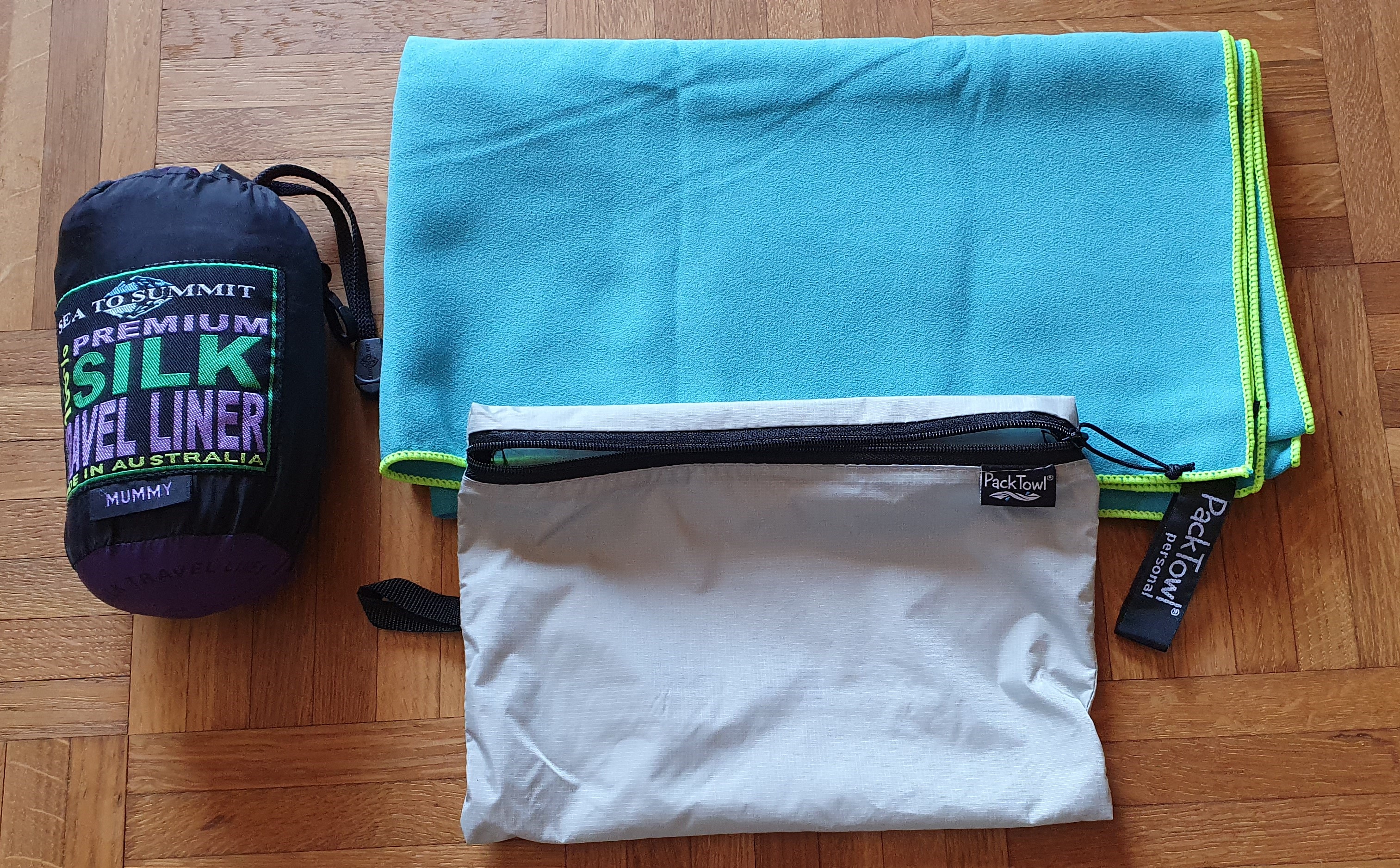
Pack towel - you will need a wash bag with some basic toiletries, miniatures are best
We hope this description has provided an insight into hut 'life', and you are willing to give it a go? We have trips that might feature just one or two hut nights, and we have trips where we stay in a hut almost every night.
If you do not want to experience a hut, then Tracks and Trails have plenty within our summer and winter programs where you can enjoy comfortable hotel accommodation every night. Our Hiking in Hidden Tuscany is a great example, where you stay in a beautiful Tuscan farmhouse or try our Chamonix Classic Walks with comfortable chalet accommodation.
For keen snowshoe enthusiasts, our Traverse of the Chablais is a great point-to-point trip with traditional hotel accommodation every night. Or for nordic skiers, the Dolomites Ski Highlights with a great hotel in the beautiful Italian town of Dobbiaco.
On the other hand if you like the idea of spending a night high in the mountains in a remote and beautiful location then start with a trip that just has one hut night, for example, our Tour du Mont Blanc Highlights with a night in the beautiful Rifugio Bonatti pictured above. Then progress onto a trip in the Dolomites like our Dolomites High Route: Alta Via 1 trip with a number of nights in comfy Rifugio’s, with luggage transfers where you have access to your main luggage.
Once you are more accustomed to hut life and enjoy the experience that it brings then perhaps aim for a trip like our Tour del Gran Paradiso. On this trip, you carry all you need for the week in your rucksack, and benefit from sleeping in truly stunning locations.
You only live once, and sometimes it is worth taking a 'chance' on trying an experience you might not otherwise have. Most huts have a great atmosphere and the guardian and their team do their best to welcome everyone and make them feel comfortable. It can be a hugely rewarding time where you get to meet other hikers or skiers from all across the globe and exchange stories, admire the mountain views at sunset and sunrise, share time with friends and learn about other cultures, foods and the history of an area. Soak it up, relax, take it in and try to enjoy it, not everyone is lucky enough to be able to spend a 'night in the mountains'.
For more information about holidays with Tracks and Trails, speak to one of our expert team by calling +44 (0) 20 8144 64442 or emailing This email address is being protected from spambots. You need JavaScript enabled to view it. In addition to hiking we offer snowshoe and cross country skiing trips in the winter, and trail running, and family summer trips.
